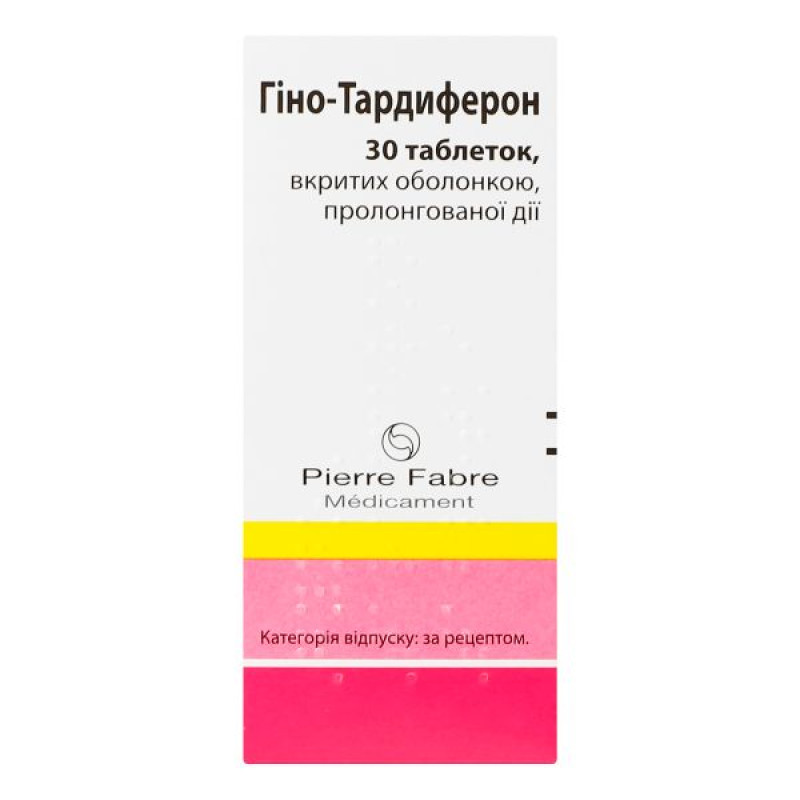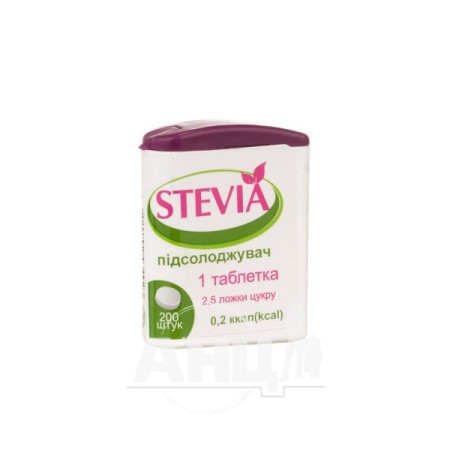Gyno-Tardiferon prolonged-release tablets coated with sugar No. 30

Instructions for Gyno-Tardiferon prolonged-release tablets coated with sugar No. 30
Composition
active ingredient: 1 tablet contains 256.3 mg of iron (II) sulfate sesquihydrate, which is equivalent to 80 mg of iron, 0.35 mg of folic acid;
Excipients: anhydrous mucoproteose, ascorbic acid, potato starch, methacrylate copolymer (type B), triethyl citrate, povidone, hydrogenated castor oil, talc, magnesium stearate, magnesium trisilicate, acrylate copolymer, titanium dioxide (E 171), sodium bicarbonate, carnauba wax, sucrose.
Dosage form
Film-coated, prolonged-release tablets.
Main physicochemical properties: round biconvex tablets, coated with a white to beige color.
Pharmacotherapeutic group
Antianemic agents. Iron preparations in combination with folic acid.
ATX code B03A D03.
Pharmacological properties
Pharmacodynamics
Gyno-Tardiferon belongs to complex iron preparations of prolonged action. The drug replenishes the deficiency of iron and folic acid in the body.
Folic acid promotes the normal course of pregnancy, prevents spontaneous abortions, participates in erythropoiesis and nucleic acid synthesis. Its deficiency can affect the pathological development of the fetal spinal cord. The high safety of Gyno-Tardiferon is due to the presence of mucoproteose. Mucoproteose is a natural mucopolysaccharide that protects the mucous membrane of the gastrointestinal tract from irritation by iron ions; promotes the slow release of iron over 5-6 hours, which significantly improves the tolerability of the drug. Ascorbic acid as an antioxidant increases the bioavailability of iron and promotes its absorption.
Pharmacokinetics
Absorption occurs in the duodenum and proximal small intestine.
Iron salts are usually poorly absorbed (10-20% of the dose taken). The gradual release of iron promotes better absorption over a long period of time.
Folic acid is rapidly released in the stomach and is present in the proximal small intestine.
Indication
Prevention and treatment of folate deficiency and iron deficiency anemia, including in women during pregnancy, when adequate intake of iron and folic acid from food cannot be ensured.
Contraindication
Hypersensitivity to the active ingredients or to other components of the drug. Excessive iron content in the body (hemosiderosis, hemochromatosis), anemias not caused by iron deficiency (for example, megaloblastic anemia caused by vitamin B9 or B12 deficiency (pernicious anemia), hemolytic anemia, aplastic anemia, sideroachrestic anemia, iron-refractory anemia, anemia in lead poisoning, thalassemia); esophageal stenosis and/or other obstructive diseases of the digestive tract, intestinal diverticulum, intestinal obstruction; regular blood transfusions, simultaneous use of parenteral forms of iron, malignant neoplasms.
Interaction with other medicinal products and other types of interactions
Iron salts reduce the absorption of concomitant medications such as tetracycline, DNA gyrase inhibitors (e.g. ciprofloxacin, levofloxacin, norfloxacin, ofloxacin), diphosphonate, penicillamine, levodopa, carbidopa and methyldopa, penicillin, sulfasalazine. Iron salts reduce the absorption of thyroxine, zinc absorption. Iron absorption is reduced by concomitant administration of cholestyramine, antacids (containing aluminum, magnesium, calcium, bismuth), and calcium and magnesium supplements. Concomitant administration of iron salts with nonsteroidal anti-rheumatic drugs may increase the irritating effect of iron on the gastrointestinal mucosa. Iron absorption may be slowed by concomitant intravenous administration of chloramphenicol. Therefore, the time interval between taking Gyno-Tardiferon and cyclines should be at least 2-3 hours, penicillamine - at least 2 hours, quinolones - at least 4 hours, antacids - at least 1-2 hours, other above-mentioned drugs - at least 2-3 hours. If necessary, the effectiveness of simultaneous administration of drugs should be checked by medical or laboratory diagnostic methods. Antibiotics of the tetracycline group, as well as penicillin, form complex compounds with iron sulfate, which reduce the absorption of iron and antibiotics. Vitamin C or citric acid promote iron absorption. Glucocorticoids can enhance the stimulation of erythropoiesis. Simultaneous administration of vitamin E can reduce the pharmacological effect of iron in the child's body. Simultaneous use of iron salts and allopurinol should be avoided.
The absorption of folic acid is reduced when used simultaneously with analgesics, anticonvulsants, antacids, cholestyramine, sulfonamides, antibiotics, cytostatics (methotrexate), trimethoprim. When used simultaneously with chloramphenicol, neomycin, polymyxins, tetracyclines, the absorption of folic acid is reduced. When used simultaneously, folic acid reduces the effects of primidone, PAS, sulfasalazine, hormonal contraceptives for oral administration, chloramphenicol, phenytoin, increasing its metabolism.
Application features
It should be noted that iron deficiency anemia associated with inflammatory syndromes is not treatable with iron preparations.
In case of anemia, it is necessary to establish the etiological causes of its occurrence.
The drug contains sucrose, which should be taken into account when prescribing it to patients with diabetes.
Since the drug contains sucrose, it is contraindicated in patients with fructose intolerance, glucose/galactose malabsorption syndrome or sucrase-isomaltase insufficiency.
Castor oil, which is part of the drug, can cause stomach upset and diarrhea.
The drug may change the color of stool to black, which may interfere with the diagnosis of chronic bleeding in the digestive tract. The fecal occult blood test sometimes gives false positive results.
Due to the risk of mouth ulcers and tooth discoloration, the tablets should not be chewed, sucked or held in the mouth. They should be swallowed whole with a large glass of water.
Eggs and milk, black tea, coffee, bread, raw cereals, dairy products inhibit iron absorption. Oral iron preparations should not be taken within 1-2 hours after consuming the above-mentioned foods. Do not take with iron-containing medications.
Use with caution in patients with the following diseases: leukemia, chronic liver and kidney diseases, inflammatory diseases of the gastrointestinal tract, gastric and duodenal ulcers, intestinal diseases (enteritis, ulcerative colitis, Crohn's disease). Exacerbation is possible in patients with rheumatoid arthritis. To prevent constipation, the drug should be washed down with plenty of fluids.
The following parameters should be determined approximately every 4 weeks to assess the degree of iron deficiency, response to treatment, and the need for continued iron supplementation: hemoglobin, red blood cell count, mean red blood cell volume, mean red blood cell hemoglobin content, reticulocyte count, serum iron, transferrin. Serum ferritin can be used to assess iron stores; a serum ferritin level < 15 μg/L indicates that the body does not have iron stores.
With prolonged use, monitoring of vitamin B12 levels is necessary.
Use during pregnancy or breastfeeding
Teratological studies in animals have not revealed malformations in the offspring of mice and rats that received iron preparations during pregnancy at doses 1100 times higher than the therapeutic level for humans.
Adequate studies on pregnant women have not been conducted, however, an analysis of bibliographic data did not reveal any information about developmental defects in children of women who took iron supplements during pregnancy.
Iron passes into breast milk in small amounts (about 0.25 mg/day).
During pregnancy or breastfeeding, Gyno-Tardiferon tablets should be taken only after consulting a doctor.
Ability to influence reaction speed when driving vehicles or other mechanisms
Does not affect.
Method of administration and doses
For oral use in adults and children aged 7 years and over.
Swallow the tablets whole. Do not chew, suck or hold the tablets in your mouth. Take with a large glass of water before or during meals, depending on gastrointestinal tolerance.
For the prevention of iron deficiency anemia (especially in pregnant women): 1 tablet per day on an empty stomach.
Treatment of iron deficiency anemia: children over 7 years old - 1 tablet per day (in the morning); adults - 1-2 tablets per day (in the morning and evening).
The duration of treatment is determined by the doctor depending on the severity of the clinical picture. After normalization of hemoglobin levels, continue taking 1 tablet daily in the morning before breakfast for 1-3 months.
Children
Do not use in children under 7 years of age.
Overdose
The use of recommended doses cannot lead to an excess of iron in the body.
If the recommended doses are exceeded, overdose symptoms are possible.
Symptoms. Acute iron overdose can cause nausea and vomiting, and in severe cases, collapse and death. The lethal dose of elemental iron is considered to be 180-300 mg/kg body weight. However, for some patients, a dose of elemental iron of 30 mg/kg may be toxic.
Symptoms of acute iron poisoning may appear within 10-60 minutes or after several hours. Abdominal pain, epigastric pain, nausea, diarrhea with green stools and later tarry stools, melena, vomiting and vomiting with blood, which may be accompanied by drowsiness, weakness, pale skin, cold clammy sweat, acrocyanosis, cyanosis, weak pulse, lethargy, decreased blood pressure, palpitations, fatigue, shock and coma, confusion, symptoms of hyperventilation, hyperthermia, paresthesia, necrosis of the digestive tract mucosa, convulsions.
Due to the possible toxic effects of overdose, the patient should be given immediate medical attention. The delayed release of iron may delay excessive absorption and provide more time for countermeasures. In case of accidental ingestion of a larger number of tablets, the patient should consume raw eggs and milk, which will lead to the formation of insoluble iron compounds in the digestive tract and facilitate its removal from the body. The ingested tablets can be removed from the stomach by inducing vomiting in the patient.
Specific therapy. Vomiting should be checked for the presence of Gyno-Tardiferon tablets. If a sufficient number of tablets is not removed, gastric lavage with 0.9% sodium chloride solution or 1% aqueous sodium carbonate solution and a laxative should be administered. An abdominal X-ray should be performed to determine the number of tablets remaining. If the methods used to remove the tablets do not yield the desired results, surgical intervention may be necessary.
The best method of assessing the severity of the condition is to determine the serum iron content and serum iron binding capacity (SIBC) of the blood. If the serum iron level is higher than the SIBC, systemic toxicity is likely.
Deferoxamine may be necessary. Deferoxamine chelation therapy should be performed if:
– a potentially lethal dose was taken (180-300 mg/kg or more);
– serum iron concentrations above 400-500 mcg/dl;
– the concentration of iron in the blood serum exceeds the ULN and/or if patients have severe symptoms of iron intoxication: coma, shock.
In acute poisoning, 5-10 g of the drug should be administered orally to bind iron that has not yet been absorbed from the digestive tract (the contents of 10-20 ampoules are dissolved in drinking water). To remove absorbed iron, deferoxamine should be administered intramuscularly at 1-2 g every 3-12 hours. In severe cases accompanied by the development of shock, patients should be prescribed an intravenous drip of 1 g of the drug and symptomatic therapy should be used.
In young children, the risk of acute iron intoxication is particularly high; life-threatening intoxication is possible with the ingestion of 1 g of ferrous sulfate.
If necessary, treatment for shock and acidosis should be carried out.
Patients with oliguria/anuria should be treated with peritoneal dialysis or hemodialysis.
Adverse reactions
Depending on the frequency, adverse reactions are divided into the following categories: very common (≥ 1/10), common (≥ 1/100, < 1/10), uncommon (≥ 1/1000, < 1/100), rare (≥ 1/10,000, < 1/1000), isolated (< 1/10,000), with an unknown frequency (available data do not allow to estimate the frequency of these reactions).
On the part of the immune system
With unknown frequency: hypersensitivity reactions, urticaria.
Respiratory, thoracic and mediastinal disorders
Uncommon: laryngeal edema.
From the digestive tract
Common: constipation, diarrhea, bloating, abdominal pain, change in stool color, nausea.
Uncommon: abnormal bowel movements, dyspepsia, vomiting, gastritis.
Frequency not known: anorexia, tooth discoloration and/or mouth ulcers when tablets are chewed, sucked or held in the mouth. If the tablet is retained in the esophagus or enters the respiratory tract, elderly patients or patients with swallowing disorders may develop esophageal ulcers or bronchial necrosis. In rare cases, if the tablets are used incorrectly, a bitter taste in the mouth may occur.
Skin and subcutaneous tissue disorders
Uncommon: pruritus, erythematous rash.
Expiration date
3 years.
Storage conditions
Store in the original packaging out of the reach of children at a temperature not exceeding 25 ºС.
Packaging
10 tablets in a blister; 3 blisters in a cardboard box.
Vacation category
According to the recipe.
Producer
Pierre Fabre Medicament Production/Pierre Fabre Medicament Production.
Location of the manufacturer and its business address
Progipharm production site, Rue du Lycee, 45500 Gien, France/Site Progipharm, Rue du Lycee, 45500 Gien, France.
There are no reviews for this product.
There are no reviews for this product, be the first to leave your review.
No questions about this product, be the first and ask your question.








